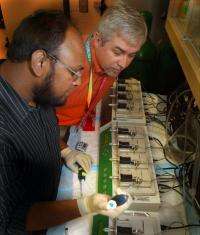Fat yet muscular mouse provides clues to improving cardiovascular health

A fat yet muscular mouse is helping researchers learn whether more muscle improves the cardiovascular health of obese individuals.
"We are looking for ways to counteract the unhealthy effects of fat," said Dr. David Stepp, vascular biologist at the Medical College of Georgia Vascular Biology Center and co-director of MCG's Diabetes & Obesity Discovery Institute.
Obesity increases the risk for cardiovascular disease as well as diabetes, which essentially doubles the cardiovascular risk. But Stepp's laboratory research indicates more muscle could reduce that risk – a theory bolstered by people who appear "fit and fat." He recently received a $450,000 exploratory grant from the National Institutes of Health to further explore the possibilities.
The fact is that people – and mice – with more muscle have more blood vessels, use more oxygen and energy and eliminate more glucose even sitting still than their flabbier counterparts. "Fat does not consume a lot of energy and it's not very vascular," Stepp said. "Muscle and nerves, on the other hand, generate electricity, which is one of the most energetically expensive things we do." The heart and blood vessels also thrive with increased blood flow and diabetes risk is reduced by muscles' glucose disposal capabilities.
"The question is, if nothing else changes, if you are still fat and inactive, does having big muscles improve metabolic and cardiovascular function," Stepp said.
If the answer is "yes," myostatin inhibitors, already under study for muscle wasting diseases such as muscular dystrophy, could help break the unhealthy vicious cycle of inactivity promoting obesity and obesity impeding exercise. "Giving someone myostatin inhibitors is not going to magically fix their problems, but it may give them a little bit of a performance edge that gets them up and moving," Stepp said, particularly the heaviest individuals.
The hormone myostatin – which means "muscle stop" - is found at low levels during development but increases in adulthood when growth is supposed to stop. "If you express myostatin, your muscles stop growing at some point," he said. Exercise can help reduce myostatin levels and build muscle.
Stepp is studying a mouse that is a cross between "mighty mouse," a muscular rodent that lacks myostatin, and one that gets fat because of a diminished fullness sensation. The resulting mouse is literally quite a handful, said Stepp, noting that, unlike humans, mice tend not to overeat unless changes are made to food centers in the brain.
He wants to see whether the fat but muscular mouse has better cardiovascular function than its purely fat counterparts. That means looking at various related factors such as the ability to dilate blood vessels, which improves blood flow; production of antioxidants that promote inflammation and cardiovascular damage; and the heart's ability to pump blood.
These pursuits can help determine how muscle and exercise benefit the cardiovascular system as they target one of obesity's most debilitating and deadly risks.
"Even if you don't lose weight, exercise does good things. It limits metabolic damage, it limits cardiovascular damage," Stepp noted. "If we could get people over the hump where they could be stronger, they can be more active and hopefully lose some weight."
















